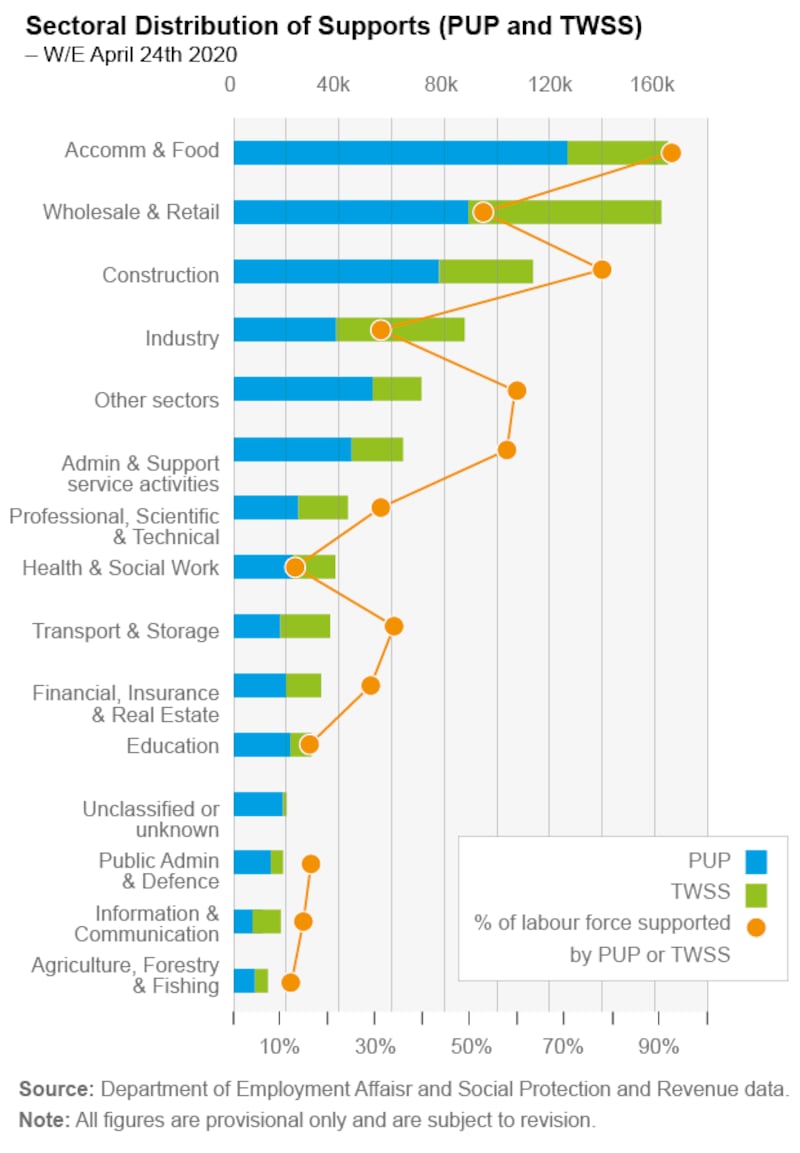The Government – or its successor – faces a difficult job in plotting the future of the Covid-19 income and wage supports. Due to run out at the end of June, the signals are that they will continue for a bit longer – Taoiseach Leo Varadkar said as much in the Dáil on Thursday. However he added that they could not continue forever. The Minister for Finance Paschal Donohoe has referred to a " pathway" – presumably one which sees the schemes being phased out at some stage. But how, and when, will be politically incendiary and have a big impact on many people and businesses. Meanwhile, the big rise in unemployment will push the Government into a much more active involvement in the jobs market.
1. The backdrop
Before the crisis 2.36 million people were in work in the Republic. Now, more than one million of those are on some kind of State income supports. Close to 600,000 are on the Pandemic Unemployment Payment (PUP) of €350 a week. A further 427,000 are having their wages supported by the Government temporary wage subsidy, generally to a maximum of 70 per cent of earnings (with some exceptions) up to €410 a week. To this, in terms of State payments, we can add around 200,000 people who were on the Live Register before the crisis started.

Some sectors are facing huge challenges, An analysis by the Department of Employment Affairs and Social Protection and the Central Bank shows that more than nine out of 10 employees in the accommodation/food and retail/wholesale sectors are now covered by one of the schemes, and six out of 10 construction workers. Those hit are more likely to be younger, female, have come here from another country and be lower paid than the average. Previous CSO data shows that on average employees in these sectors have little by way of financial resources – typically two weeks' wages.
2. The hints
The Taoiseach Leo Varadkar and Minister for Finance Paschal Donohoe have clearly indicated that the Government is considering the future of the schemes. Donohoe said this week that as well as protecting citizens, the supports must be affordable. The Taoiseach said that there could not be three different types of unemployment payments in the long term – those relating to pre Covid-19, those hit by the crisis and those who become unemployed in the future. However, the Government appears to still be a few weeks from a decision, as the options start to be costed out and assessed. Indeed if the talks to form a new government succeed, it is likely that a final call on what happens could be one of its first decisions, in what will surely be a political baptism of fire.
The cost of the schemes runs into hundreds of millions a week, but the future price will depend crucially on the economic reopening plan. Donohoe told Virgin Media News that if the first phase of the reopening plan happens on schedule, then 60,000 to 80,000 could quickly return to work. These would mainly be construction workers, many of whom are on the PUP and some on wage subsidies. Reopening further sectors would then cut the cost further over the summer – but this is crucially reliant on success in controlling the spread of the virus. If more get back to work, costs will fall sharply.

3. The options
As the crisis broke and the schemes were introduced, the Government spoke of turning the economy off and then turning it back on again a few months later. It is now clear that the challenge is complicated, as all talk of a quick V-shaped recovery has been replaced by fears of a longer downturn.
On the wage subsidy, the challenge is to get the timing right and ensure that employers can afford to keep employees on their books as they restart, or that those who have operated all along have a reasonable chance of seeing an uplift in business and thus holding on to the staff they have. This suggests that the subsidy is likely to be phased down gradually, rather than cut, as this would risk throwing significant numbers into unemployment .
The key decisions facing the Government, or its successor, will first be how quickly to wind down the scheme and second whether to put in place ongoing supports, either across the board or focused on some sectors facing particular difficulties. The first call will be when to cut off new applications for the scheme – with perhaps some limited options in future when companies are re-employing staff.
What then of companies now getting support? The economic advice – likely to be taken given the prolonged nature of the reopening plan – would be to avoid a “cliff edge” – in others words a major change in payment levels all at once which could spark redundancies. So a gradual wind-down, say from 70 per cent maximum to 60 per cent and 50 per cent and so on may be more likely. The Government would certainly aim to safeguard as many jobs as possible until sectors are restarted and the jobs market has some momentum.A more difficult question is whether to offer ongoing supports for a longer period, particularly in the worst-affected sectors.
On the PUP, the indications from Varadkar have been that the changes would await the reopening of sectors in which people worked. Given the administrative complexities, the easiest solution would thus be to extend the €350 a week payment until at least until the middle of August, when all sectors are due to be reopened.
The alternative would be some kind of sectoral roll-back as different parts of the economy reopen, but this may be too complicated.Consideration may also be given to cutting eligibility, or introducing lower payments, perhaps for students who were engaged in part-time work.
These are politically difficult decisions – and an even tricker one is the question of what happens when all sectors are back at work, but tens of thousands still remain reliant on the payments.
The Government may want to start moving people likely to remain in unemployment for a prolonged period down towards the normal unemployment benefit level, which is €205 a week for a single person. Again, given the need to avoid a cliff edge, this is likely to happen on a phased basis. The how and when of this will be hugely controversial.
4. The worst-affected sectors
Construction and manufacturing may restart successfully, as well as the digital economy, but the domestic services sector faces real challenges, as we know . Restaurants, pubs, arts and events and hospitality all face huge problems. Overseas tourism is unlikely to resume this year, or at most at very low levels later in the year. For many, even when allowed to reopen, the question is whether it is viable to do so with social distancing rules and changed consumer habits challenging their business model severely. Sectoral groups are now calling for stepped -up supports – and some are likely in areas such as tourism.
But the Government will still face real challenges in trying to judge where to direct business supports in areas which are fundamentally upended at least until a vaccine or effective treatment is found, or the virus is firmly on the wane.
And what of the job of protecting many employees facing prolonged redundancy? There were 128,500 people in the accommodation and food sector before this hit, many facing an uncertain future. As we saw above, many are younger than the average and have less in the way of financial resources. Many people in this sector have been well supported to date – the study points out the average take-home pay is around €460 a week, just €110 above the pandemic payment and a minority will have been better off on the payment. The Department/Central Bank report says that incentives must be there for people to return to work, another factor in the mix of decision-making .
5. Supporting the jobs market
The State is likely to have to play a more active role in the jobs market coming out of the crisis.. The Department/Central Bank report says that people may need help in finding employment and the smallest employers in particular may need assistance to help them take staff back on. One option may be to continue to subsidise employers for a period if they re-employ staff or take on new employees from the Live Register or the Covid-19payment scheme.
The Government is now being advised on more active policies by a group of experts, officials and employer and union representatives meeting in the Labour Market Advisory Council, chaired by former senior OECD official and employment expert John Martin.
The areas it is looking at provide hints of where the Government might go next. They include so-called short-time work supports – help for companies taking employees back on initially on a part-time basis, in the hope that in time the job can be full-time again. The group is also looking at the option of targeting supports by sector and by region – parts of rural Ireland reliant on tourism are heavily exposed, for example.
And it examined a report from the Institute for Employment Studies in the UK, which warned about the long-term impact on young people becoming unemployed – to their earnings, prospects, health and well-being – and the need for policies to address this. It called for an active jobs market programme in the UK, including rapid supports and a new back-to-work scheme, offering an additional subsidy to those who agree to become engaged in work experience and internships. It also called for new investment in general retraining of unemployed workers and a special focus on younger people with a commitment to offer education, training and job placements.
These are the kind of issues which will come on the agenda here if the jobs downturn is prolonged. The European Commission said this week that unemployment might return to pre-crisis levels here by the end of next year. Most domestic forecasters see this as way too optimistic. We do not know what the next few months will bring, but jobs and unemployment are firmly back on the policy agenda,











